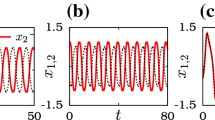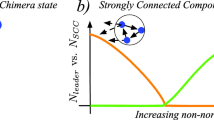Abstract
Aging transition refers to the manifestation of the homogeneous steady state beyond a critical ratio of the inactive oscillators in a network of active and inactive oscillators. In contrast, symmetry breaking in coupled dynamical systems always results in heterogeneous states. In this work, surprisingly, we find that the symmetry breaking coupling facilitates the onset of the homogeneous steady state among the population at the critical proportion of the inactive oscillators despite the presence of a large number of the active oscillators. Further, increase in the natural frequency of the oscillation and the number of the inactive oscillators are conducive to the onset of the aging transition. Interestingly, chimera-like death state is observed in the study related to the aging transition for the first time in the literature in addition to the actual chimera death states among the active oscillator for the random initial conditions. The critical curves corresponding to the stability of the aging transition and the chimera-like death states are deduced, which agrees perfectly with the simulation results. Even a feeble decrease in the feedback factor in the coupling destabilizes the stable aging state thereby facilitating the oscillatory state in the entire parameter space despite the presence of a large proportion of the inactive oscillators increasing the robustness of the network against disorders.











Similar content being viewed by others
References
Pikovsky, A., Rosenblum, M.G., Kurths, J.: Synchronization: A Universal Concept in Nonlinear Sciences. Cambridge University Press, Cambridge (2001)
Suresh, R., Senthilkumar, D.V., Lakshmanan, M., Kurths, J.: Global and partial phase synchronizations in arrays of piecewise linear time-delay systems. Int. J. Bifurc. Chaos 22, 1250178 (2012)
Kapitaniak, M., Czolczynski, K., Perlikowski, P., Stefanski, A., Kapitaniak, T.: Synchronous states of slowly rotating pendula. Phys. Rep. 541, 1–44 (2014)
Pecora, L.M., Sorrentino, F., Hagerstrom, A.M., Murphy, T.E., Roy, R.: Cluster synchronization and isolated desynchronization in complex networks with symmetries. Nat. Commun. 5, 4079 (2014)
Panaggio, M.J., Abrams, D.M.: Chimera states: coexistence of coherence and incoherence in networks of coupled oscillators. Nonlinearity 28, R67 (2015)
Kalle, P., Sawicki, J., Zakharova, A., Schöll, E.: Chimera states and the interplay between initial conditions and non-local coupling. Chaos 27, 033110 (2017)
Mishra, A., Saha, S., Roy, P.K., Kapitaniak, T., Dana, S.K.: Multicluster oscillation death and chimeralike states in globally coupled Josephson Junctions. Chaos 27, 023110 (2017)
Banerjee, T., Biswas, D., Ghosh, D., Schöll, E., Zakharova, A.: Networks of coupled oscillators: from phase to amplitude chimeras. Chaos 28, 113124 (2018)
Sathiyadevi, K., Chandrasekar, V.K., Senthilkumar, D.V., Lakshmanan, M.: Imperfect amplitude mediated chimera states in a nonlocally coupled network front. Appl. Math. Stat. 4, 58 (2018)
Sathiyadevi, K., Chandrasekar, V.K., Senthilkumar, D.V., Lakshmanan, M.: Distinct collective states due to trade-off between attractive and repulsive couplings. Phys. Rev. E 97, 032207 (2018)
Saxena, G., Prasad, A., Ramaswamy, R.: Amplitude death: the emergence of stationarity in coupled nonlinear systems. Phys. Rep. 521, 205–228 (2012)
Banerjee, T., Ghosh, D.: Experimental observation of a transition from amplitude to oscillation death in coupled oscillators. Phys. Rev. E 89, 062902 (2014)
Banerjee, T., Ghosh, D.: Transition from amplitude to oscillation death under mean-field diffusive coupling. Phys. Rev. E 89, 052912 (2014)
Zou, W., Senthilkumar, D.V., Duan, J., Kurths, J.: Emergence of amplitude and oscillation death in identical coupled oscillators. Phys. Rev. E 90, 032906 (2014)
Pahwa, S., Scoglio, C., Scala, A.: Abruptness of cascade failures in power grids. Sci. Rep. 4, 3694 (2014)
Daido, H., Nakanishi, K.: Aging and clustering in globally coupled oscillators. Phys. Rev. E 75, 056206 (2007)
Daido, H., Nakanishi, K.: Aging transition and universal scaling in oscillator networks. Phys. Rev. Lett. 93, 104101 (2004)
Daido, H.: Suppression and recovery of spatiotemporal chaos in a ring of coupled oscillators with a single inactive site. Europhys. Lett. 87, 40001 (2009)
Daido, H.: Dynamics of a large ring of coupled active and inactive oscillators. Phys. Rev. E 83, 026209 (2011)
Huang, W., Zhang, X., Hu, X., Zou, Y., Liu, Z., Guan, S.: Variation of critical point of aging transition in a networked oscillators system. Chaos 24, 023122 (2014)
Tanaka, G., Morino, K., Daido, H., Aihara, K.: Dynamical robustness of coupled heterogeneous oscillators. Phys. Rev. E 89, 052906 (2014)
Daido, H.: Aging transition and disorder-induced coherence in locally coupled oscillators. Europhys. Lett. 84, 10002 (2008)
Morino, K., Tanaka, G., Aihara, K.: Robustness of multilayer oscillator networks. Phys. Rev. E 83, 056208 (2011)
Thakur, B., Sharma, D., Sen, A.: Time-delay effects on the aging transition in a population of coupled oscillators. Phys. Rev. E 90, 042904 (2014)
Kundu, S., Majhi, S., Karmakar, P., Ghosh, D., Rakshit, B.: Augmentation of dynamical persistence in networks through asymmetric interaction. Euro. Phys. Lett. 123, 30001 (2018)
Kundu, S., Majhi, S., Ghosh, D.: Resumption of dynamism in damaged networks of coupled oscillators. Phys. Rev. E 97, 052313 (2018)
Sun, S., Ma, N., Xu, W.: Aging transition by random errors. Sci. Rep. 7, 42715 (2017)
Zakharova, A., Kapeller, M., Schöll, E.: Chimera death: symmetry breaking in dynamical networks. Phys. Rev. Lett. 112, 154101 (2014)
Premalatha, K., Chandrasekar, V.K., Senthilvelan, M., Lakshmanan, M.: Impact of symmetry breaking in networks of globally coupled oscillators. Phys. Rev. E 91, 052915 (2015)
Zou, W., Senthilkumar, D.V., Nagao, R., Duan, J., Kurths, J.: Restoration of rhythmicity in diffusively coupled dynamical networks. Nat. Commun. 6, 7709 (2015)
Liu, Y., Zou, W., Zhan, M., Duan, J., Kurths, J.: Enhancing dynamical robustness in aging networks of coupled nonlinear oscillators. Europhys. Lett. 114, 40004 (2016)
Mukherjee, R., Sen, A.: Amplitude mediated chimera states with active and inactive oscillators. Chaos 28, 053109 (2018)
Chandrasekar, V.K., Karthiga, S., Lakshmanan, M.: Feedback as a mechanism for the resurrection of oscillations from death states. Phys. Rev. E 92, 012903 (2015)
Senthilkumar, D.V., Suresh, K., Chandrasekar, V.K., Zou, W., Dana, S.K., Thamilmaran, K., Kurths, J.: Experimental demonstration of revival of oscillations from death in coupled nonlinear oscillators. Chaos 26, 043112 (2016)
Deng, T., Liu, W., Xiao, J., Kurth, J.: Conjugate coupling-induced symmetry breaking and quenched oscillations. Choas 26, 094813 (2016)
Koseska, A., Volkov, E., Kurths, J.: Transition from amplitude to oscillation death via turing bifurcation. Phys. Rev. Lett. 111, 024103 (2013)
Punetha, N., Varshney, V., Sahoo, S., Saxena, G., Prasad, A., Ramaswamy, R.: Dynamical effects of breaking rotational symmetry in counter-rotating Stuart–Landau oscillators. Phys. Rev. E 98, 022212 (2018)
Daido, H.: Multibranch entrainment and scaling in large populations of coupled oscillators. Phys. Rev. Lett. 77, 1406–1409 (1996)
Kuramoto, Y., Nakao, H.: Origin of power-law spatial correlations in distributed oscillators and maps with nonlocal coupling. Phys. Rev. Lett. 76, 4352 (1996)
Kuramoto, Y., Nakao, H.: Power-law spatial correlations and the onset of individual motions in self-oscillatory media with non-local coupling. Physica D 103, 294–313 (1997)
Kuramoto, Y., Battogtokh, D., Nakao, H.: Multiaffine chemical turbulence. Phys. Rev. Lett. 81, 3543 (1998)
Kuramoto, Y., Battogtokh, D.: Coexistence of coherence and incoherence in nonlocally coupled phase oscillators. Nonlinear Phenom. Complex Syst. 5, 380 (2002)
Schmidt, L., Schönleber, K., Krischer, K., García-Morales, V.: Coexistence of synchrony and incoherence in oscillatory media under nonlinear global coupling. Chaos 24, 013102 (2014)
Thompson, M.C., Gal, P.L.: The Stuart–Landau model applied to wake transition revisited. Eur. J. Mech. B Fluids 23, 219–228 (2004)
Frasca, M., Bergner, A., Kurths, J., Fortuna, L.: Bifurcations in a star-like network of Stuart–Landau oscillators. Int. J. Bifurc. Chaos 22, 1250173 (2012)
Moon, J.-Y., Lee, U., Blain-Moraes, S., Mashour, G.A.: General relationship of global topology, local dynamics, and directionality in large-scale brain networks. PLoS Comput. Biol. 11, e1004225 (2015)
Initial condition is chosen as \((x_j , y_j) \in (0, 0)\) for \(j=1, 2, \ldots , N-1\) and \((x_N , y_N) \in (\pm u, 0)\) for uniform random number \(u\) between \(0\) and \(1\)
Initial condition is chosen as \((x_j , y_j) \in (u, -v)\) if \(j\) is odd and \((x_j , y_j) \in (-u, v)\) if \(j\) is even or vice versa for uniform random numbers \(u\) and \(v\) between \(0\) and \(1\)
Loos, S.A.M., Claussen, J.C., Schöll, E., Zakharova, A.: Chimera patterns under the impact of noise. Phys. Rev. E 93, 012209 (2016)
Sathiyadevi, K., Chandrasekar, V.K., Senthilkumar, D.V.: Stable amplitude chimera in a network of coupled Stuart–Landau oscillators. Phys. Rev. E 98, 032301 (2018)
Ermentrout, B.: Simulating, Analyzing and Animating Dynamical Systems: A Guide to Xppaut for Researchers and Students (Software, Environments, Tools). SIAM Press, Philadelphia, PA (2002)
Acknowledgements
IG wishes to thank SASTRA Deemed University for research fund and extending infrastructure support to carry out this work. KS and DVS is supported by the CSIR EMR Grant No. 03(1400)/17/EMR-II. The work of VKC forms part of a research project sponsored by CSIR Project under Grant No. 03(1444)/18/EMR-II.
Author information
Authors and Affiliations
Corresponding authors
Ethics declarations
Conflict of interest
The authors declare no conflict of interest.
Additional information
Publisher's Note
Springer Nature remains neutral with regard to jurisdictional claims in published maps and institutional affiliations.
Appendices
Appendix A: Aging state
The coefficients \(\beta _0,~\beta _1,~\beta _2,\) and \(\beta _3\) for the above characteristic eigenvalue equation (3) are given by
where
Appendix B: Chimeralike state
The coefficients \(\gamma _0,~\gamma _1,~\gamma _2,~\gamma _3,~\gamma _4,\) and \(\gamma _5\) for the above characteristic eigenvalue equation (3) are given by
where
Rights and permissions
About this article
Cite this article
Gowthaman, I., Sathiyadevi, K., Chandrasekar, V.K. et al. Symmetry breaking-induced state-dependent aging and chimera-like death state. Nonlinear Dyn 101, 53–64 (2020). https://doi.org/10.1007/s11071-020-05766-5
Received:
Accepted:
Published:
Issue Date:
DOI: https://doi.org/10.1007/s11071-020-05766-5




